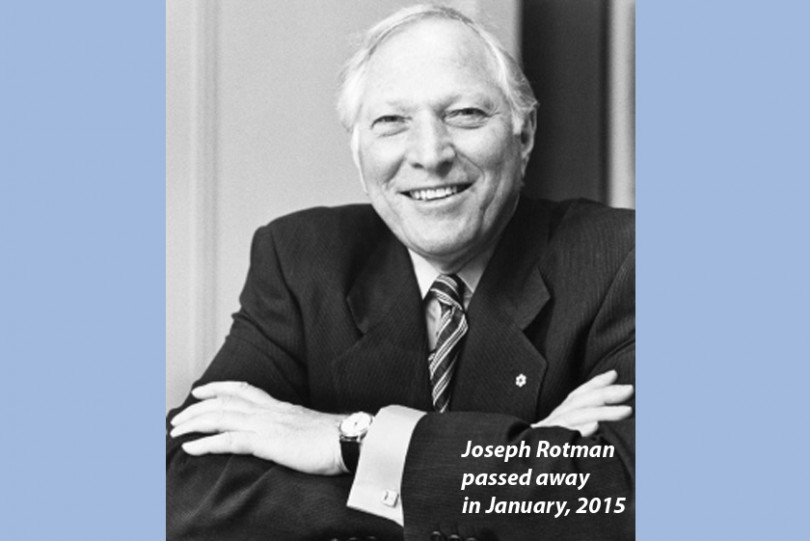Joseph L. Rotman, age 72
Joseph L. Rotman knows well the benefits of good orthopaedic surgery and stresses the importance of rehabilitation to the healing process. One of Canada’s best-known businessmen, Joe continues to build his successes in family, business, and philanthropy in the arts, health and health research, and education. His life is even more inspirational when one learns that he achieved these successes while enduring pain and restricted mobility. Over thirty years, Joe needed a variety of orthopaedic surgeries that started with repair of a sports injury to, most recently, two knee replacements that finally alleviated his pain and got him back on skis.
Following a serious ski accident in Austria in 1971, Joe required surgery to repair his injury but had to wait until the surgeon finished skiing for the day. Joe laughs when he recalls his wife’s nervousness about the apparent lack of attention to her husband. “Had it been up to Sandy, she would have packed the leg in ice and brought me home to Canada!” He did have the surgery; however the procedure, never used in Canada, didn’t work as planned. Joe later suffered another injury on a trip to Italy. He was able to come home for the surgery this time but it, too, failed to deliver the anticipated outcome.
During this time, Joe was laid up for about two years on and off. He had a young family and a career on the rise, and wasn’t one to be held down for long. Of his own initiative, he took up jogging to stay fit and strengthen his leg. Joe’s health club had a square track on which he trained, and they alternated direction each day. Because of the days Joe was able to be at the track, he jogged only the same direction which may have contributed to the further deterioration of not just his bad knee, but his good one, too. “No one had told me the importance of professional physiotherapy to restore my mobility,” says Joe. Through a period of ten years Joe had three arthroscopies to repair the damage – two on one knee and one on the other.
Eventually, joint replacements were the only option to relieve Joe’s pain and discomfort. In 1991, twenty years since his first accident, he spoke to Dr. Allan Gross, an orthopaedic surgeon and former schoolmate. At that time, Dr. Gross advised Joe to wait as long as he could before having the knee replacements. “Technology was continually improving the devices used for joint replacement surgery,” said Dr. Gross, “so the longer you waited, the better the device. Also, the wisdom was, the older you are, the better as you may not require further corrective treatment.” This isn’t as true any longer; advances in technology and surgical intervention made possible through research are seeing younger joint replacement patients. “Technology is always improving,” says Dr. Gross, “just look at Joe’s history as an example.”
Over ten years later, Joe was finally paralysed with pain while walking back to his hotel in New York City with Sandy. He simply couldn’t take one more step. They returned to Toronto as soon as possible, and Joe advised Dr. Gross that he was ready for his knee replacements. He had lived in painful agony for 11 years.
As many do, Joe experienced trepidation with his upcoming double knee replacement. He sought out others who had had knee replacements to help gain greater comfort and confidence with his decision. “Speaking to others who had been there really helped, “says Joe. In July 2002, Joe had his surgery. “The results are a miracle, and the professionals were outstanding,” he says when asked how he felt following his surgery. The pain and agony he’d been living with was gone, but his full return to mobility was still a bit of a journey.
Following surgery Joe was admitted to a rehab facility for post-operative physiotherapy where he received 1 1/2 hours of therapy each day. “Sandy and I didn’t think that was enough” so Sandy, a key partner in his rehabilitation, moved him from the rehab facility to their farm for two months of therapy and rest. Joe worked a minimum of 2 1/2 hours on physiotherapy each day, and his rehabilitation included massage therapy three times a week. “You need to take the time to focus on healing, walking, and regaining your body alignment and angulations for the proper use of your new knees,” says Joe.
While every case is different, Joe offers this advice to others like him: “If your surgeon tells you that you need to have both knees replaced, don’t be afraid to have them done at the same time. It helped me to realign my whole body.” When asked what made the difference in his return to mobility, Joe is quick to answer, “Rehab is absolutely critical, and patients need to understand their part in their own recovery and be helped to find professionals to work with them.” His hard work paid off – in family, business, and his physical mobility, too. Joe returned to skiing in March 2003 and says, “2006 has been his best skiing season yet!”
The Canadian Orthopaedic Foundation is Canada’s only charity dedicated solely to helping people maintain and restore their mobility. Our mission is to achieve excellence in bone and joint health, mobility and function through the advancement of research, education and care. The Canadian Orthopaedic Foundation provides information and peer support to individuals receiving orthopaedic treatment and their families. For more information about these services, call 1-800-461-3639 or click on “Patient Support and Resources” on our website at www.whenithurtstomove.org.


